 |
Home | Charity | Feedback |
Japan:
Hakone - Mt. Fuji,
Kyoto,
Osaka,
Tokyo
Tokyo, Japan: Life in the fast lane by Prakash Bang, Editor in Chief 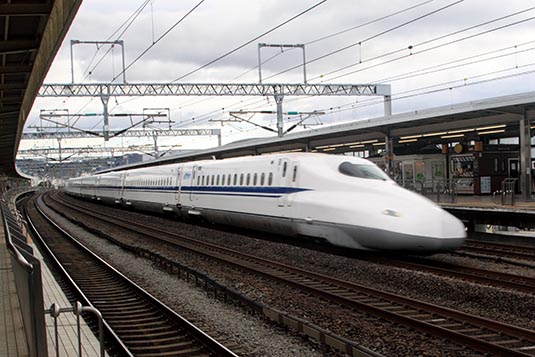 Like its bullet trains, people in Tokyo speed past. It’s always a rush hour – well at least in the District of Ginza. Streets are dotted by speeding dark suits, a national business dress I guess. I was to be in Tokyo only for a night; meaning I just had a total of a day to soak in as much as I could. I had to speed up too. I arrived in Tokyo from Odawara. I took the 10:11 Shinkansen – The Kodama Express from Odawara to arrive at Tokyo central station, as scheduled at 10:47. More about Shinkansen, the Bullet Train as we all know it, in an article on Hakone. An unreserved ticket for this 36-minute ride was ¥3250. 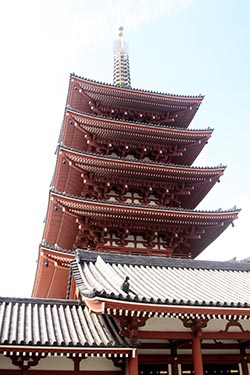 For the night I had opted to stay at Hotel Monterey Le Soeur Ginza. The Ginza area is the most happening of all places in Tokyo. It’s a commercial district as also the fashion capital of Japan. You name the brand, and you would find their presence. Contemporary designed buildings in the mornings wear a totally different look after sunset. Illuminated signages transform the streets into one large nightclub!
For the night I had opted to stay at Hotel Monterey Le Soeur Ginza. The Ginza area is the most happening of all places in Tokyo. It’s a commercial district as also the fashion capital of Japan. You name the brand, and you would find their presence. Contemporary designed buildings in the mornings wear a totally different look after sunset. Illuminated signages transform the streets into one large nightclub!
And large it is. Ginza is zoned 1 to 8. Columns and rows of Streets and Avenues make for a wonderful neighbourhood. The famous Ginza Crossing is in the Ginza 4 zone. It’s a crossing where pedestrians can cross the street and the avenue diagonally too. At peak hours, a view from the top would be of interest… wherein the street won’t be visible at all… just heads. When the lights turn green, vehicles take over. They do speed. My hotel was in Ginza 1. From Tokyo station I took the JR line and alighted at the next stop which was Yurakucho. My Shinkansen ticket from Odawara to Tokyo, gave me the privilege to pass the JR gate. Or so I guess because the ticket checker allowed me to walk without even asking me a question. From Yurakucho station I walked to the hotel (a good 20 minute) passing through Ginza and Chuo Dori – the main road. I later realized that I could have walked from Tokyo station directly to the hotel through a different route. Well, Google maps are handy but not always. The locals know a better way as I found out on my way out from Tokyo. 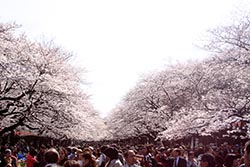 Hotel Monterey La Soeur is an excellent hotel ideally located. And by Ginza standards not very expensive either. A single room cost me ¥13000 for a night. The room was just big enough to hold a bed, a desk, a small bathroom and of course, the famous Japanese toilet system! Guys on the front desk were friendly but pretty strict. Since my flight was to depart in the evening, my request for a late check-out was politely denied. They asked for ¥1000 for every hour of delay beginning 11AM. I have never had such experience before. Hotels usually would grant a couple of hours of grace period, if not more. Well, that’s Ginza – the most expensive piece of real estate in the world… where every minute and every square foot counts!
Hotel Monterey La Soeur is an excellent hotel ideally located. And by Ginza standards not very expensive either. A single room cost me ¥13000 for a night. The room was just big enough to hold a bed, a desk, a small bathroom and of course, the famous Japanese toilet system! Guys on the front desk were friendly but pretty strict. Since my flight was to depart in the evening, my request for a late check-out was politely denied. They asked for ¥1000 for every hour of delay beginning 11AM. I have never had such experience before. Hotels usually would grant a couple of hours of grace period, if not more. Well, that’s Ginza – the most expensive piece of real estate in the world… where every minute and every square foot counts!
With limited time on hand, I had to prepare a wish list of places to visit. They were Sensoji Temple; Ueno Park; Imperial Palace; Ginza by night; Tokyo Tower and Tsukiji Fish Market. The list is not in order of priority, rather in order of how I would be visiting them… a decision based on the Tokyo Subway. 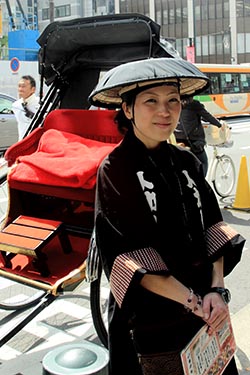 The Tokyo Subway is the world’s largest. It has 13 lines and transports over 8.70 million passengers every single day. It’s a good idea to buy special day passes at the hotel counters. The passes are slightly more expensive for similar journeys at station kiosks. I opted for a 2-day Tokyo Subway Pass that allowed unlimited travel on the system save for a couple of lines where the pass is not valid, but that should not matter much for a visitor. I paid ¥950 for the 2-day pass.
The Tokyo Subway is the world’s largest. It has 13 lines and transports over 8.70 million passengers every single day. It’s a good idea to buy special day passes at the hotel counters. The passes are slightly more expensive for similar journeys at station kiosks. I opted for a 2-day Tokyo Subway Pass that allowed unlimited travel on the system save for a couple of lines where the pass is not valid, but that should not matter much for a visitor. I paid ¥950 for the 2-day pass.
The Ginza line from the Ginza station took me straight to Asakusa. The station opens out to the doors of Tokyo’s oldest temple – The Sensoji temple and the Shinto Shrine. Built in 645 the site is a major tourist attraction. The temple was severely damaged during the bombings of World War II. It was rebuilt as a symbol of rebirth and peace for the Japanese people. The entrance of the temple is dominated by a massive paper lantern, painted in red, called Kaminarimon. On both side of the approach road, called Nakamise-dori are small shops which have attracted tourists and pilgrims for centuries. On the day of my visit, there were thousands of people. I am not too sure, but it could have been a local holiday to celebrate the onset of spring. Luring the crowd outside the temple premises were dozens of cycle rickshaws who offered to ride tourists around the neighbourhood. A 10-minute ride would cost ¥2000. 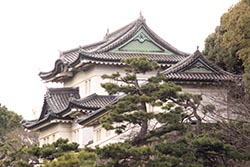 After paying my respects at the shrine and wandering around the temple grounds for a while I took the Ginza line back a couple of station to alight at Ueno that would give me walking access to Ueno Park. Today, luck was on my side. The sudden chill over Tokyo the previous week delayed the Sakura season by about a week. What I intended to see in Kyoto and Osaka, I could see it in Tokyo – 100% Sakura bloom! Ueno Park had hundreds of Sakura trees each in full bloom. Hues of white, pink and red covered the entire park. The canopies created by the Sakura invited zillions of people to enjoy their Hanami. I could have spent an entire day, like most Japanese do, under the Cherry Blossom. But since time was limited, just about an hour was OK for me. Very reluctantly I walked away from the Park knowing well, that it won’t be soon before I get to view Sakura again.
After paying my respects at the shrine and wandering around the temple grounds for a while I took the Ginza line back a couple of station to alight at Ueno that would give me walking access to Ueno Park. Today, luck was on my side. The sudden chill over Tokyo the previous week delayed the Sakura season by about a week. What I intended to see in Kyoto and Osaka, I could see it in Tokyo – 100% Sakura bloom! Ueno Park had hundreds of Sakura trees each in full bloom. Hues of white, pink and red covered the entire park. The canopies created by the Sakura invited zillions of people to enjoy their Hanami. I could have spent an entire day, like most Japanese do, under the Cherry Blossom. But since time was limited, just about an hour was OK for me. Very reluctantly I walked away from the Park knowing well, that it won’t be soon before I get to view Sakura again.
From Ueno I took the Hibiya line to Hibiya. From where I changed to Chiyoda line to Nijubashimae that would allow me access to the Tokyo Imperial Palace. 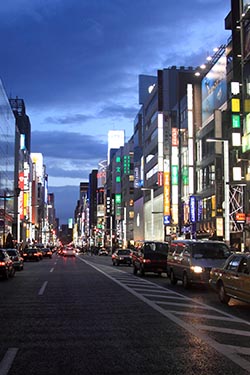 Covering an area of about 7.50 square kilometers, the Tokyo Imperial Palace is a complex containing the residence of the Emperor of Japan, private residences of the imperial family and various other buildings. Right in the heart of Tokyo, near the Tokyo station, the real estate value of the Imperial Palace will be many times more than most big cities of the world! Surrounded by a large park and a moat, the Imperial Palace is out of bound for visitors unless of course, you are a State guest, which I wasn’t. Ordinary mortals can walk along the moat to see some of the palace entrances and gates, the iconic Nijubashi (double bridge), guard towers and the guards standing in attention at the royal gate. The Imperial Palace premises offer excellent views of Tokyo around.
Covering an area of about 7.50 square kilometers, the Tokyo Imperial Palace is a complex containing the residence of the Emperor of Japan, private residences of the imperial family and various other buildings. Right in the heart of Tokyo, near the Tokyo station, the real estate value of the Imperial Palace will be many times more than most big cities of the world! Surrounded by a large park and a moat, the Imperial Palace is out of bound for visitors unless of course, you are a State guest, which I wasn’t. Ordinary mortals can walk along the moat to see some of the palace entrances and gates, the iconic Nijubashi (double bridge), guard towers and the guards standing in attention at the royal gate. The Imperial Palace premises offer excellent views of Tokyo around.
Walking along the moat I took an exit from the other side of the Imperial Palace. Government buildings were housed out here. From the station Sakuradamon I took the Yurakucho line and got down at Yurakucho from where I began to explore Ginza area on foot. I had to walk around for a couple of hours for the night to fall. Ginza by night is indeed a different animal altogether. Using the Hibiya line I got down at Kamiyacho and began my walk towards Tokyo Tower – city’s latest attraction. Built in 1958 on the lines of Eiffel Tower, but 13 meters taller, the Tokyo Tower at 333 meters is the world’s tallest self-supporting steel structure. Visitors for an entry fee of ¥820 can visit the main observatory located at 150 meters. Additional fee of ¥600 is required to visit the special observatory located at 250 meters. Visitors must allow waiting time to get onto their high speed elevators. The cost and the wait are certainly worth it. The tower offers spectacular view of Tokyo. And yes, on a clear day, you could see as far as Mount Fuji. It was 10PM by the time I reached my hotel. 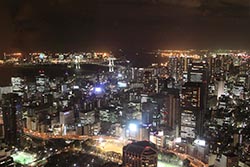 I reserved the next morning to visit the world’s largest fish and sea-food market – Tsukiji Fish Market. I could have used the subway but instead decided to walk all the way for about 2 kms from the hotel. That would give me the opportunity to walk past some famous landmarks by day. That included the Ginza Crossing, Mitsukoshi Building and the Kabukiza Theatre not to forget famous brand stores including Apple, Wako, Cartier, Chanel, Armani, De Beers, Bvlgari, Louis Vuitton and the likes.
I reserved the next morning to visit the world’s largest fish and sea-food market – Tsukiji Fish Market. I could have used the subway but instead decided to walk all the way for about 2 kms from the hotel. That would give me the opportunity to walk past some famous landmarks by day. That included the Ginza Crossing, Mitsukoshi Building and the Kabukiza Theatre not to forget famous brand stores including Apple, Wako, Cartier, Chanel, Armani, De Beers, Bvlgari, Louis Vuitton and the likes.
The ideal time to visit the market is between 5:30AM and 8AM. That’s when auction of Tuna and other varieties of fish happen. It’s quite an experience, I am told. However, I wasn’t there that early. Just behind the fish market is part of the bay. I walked over to take some pictures. 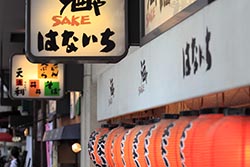 It was time to turn back. I had to check out by 11AM. Not knowing that my pass wouldn’t allow me a ride on the Oedo line, I walked to Kachidoki station from where I was advised to walk another 15 minutes to catch a train from Tsukishima station. Finally, all was well. I reached my hotel, well in time, to check out and begin my walk to Tokyo station from where I would take the Narita Express.
It was time to turn back. I had to check out by 11AM. Not knowing that my pass wouldn’t allow me a ride on the Oedo line, I walked to Kachidoki station from where I was advised to walk another 15 minutes to catch a train from Tsukishima station. Finally, all was well. I reached my hotel, well in time, to check out and begin my walk to Tokyo station from where I would take the Narita Express.
In 60 minutes I was at terminal 2. A couple of hours at the lounge and I would be on my way home. Tokyo Image Gallery  Photo viewer Photo viewer
|
|
|
Home |
Charity |
Feedback
Privacy Policy | Terms of Usage © YoGoYo.com. All rights reserved. |





































































































